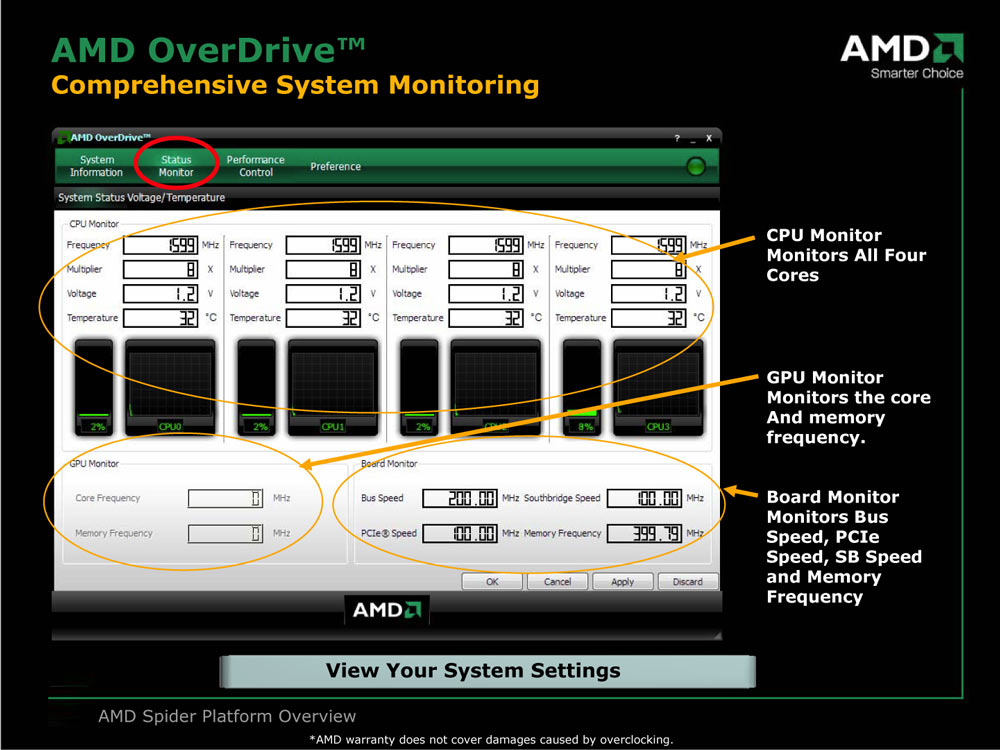

- Understand amd system monitor install#
- Understand amd system monitor software#
- Understand amd system monitor code#


Though now when I've got a good view of what's going on there, I let sleeping dogs lie after that. When I swap a component out, sure, I'll check the new kit is working as intended, and if I swap my PC case I'll keep an eye on temperatures. Nowadays, I tend to monitor my PC a little less. I used to be really obsessed with checking my temperatures and fan speeds, like annoyingly into it, and while I'm sure not everyone is going to want to to check their PC temps mid-game, I sure did. The program lies within System Utilities, more. The program's installer is commonly called System Monitor.exe, Monitor.exe, SystemMonitor64.exe, 2E758A6ACF428AD2553E12.exe or 4011480DE5FA29FD9F1F98.exe etc. The latest installation package takes up 906 KB on disk.
Understand amd system monitor software#
Now onto my second recommendation: maybe you don't always need to keep an eye on your PC's every electrical action. AMD System Monitor 1.0.0.9 can be downloaded from our software library for free.
Understand amd system monitor install#
That is a bit of an all-in-one open RGB control app that not only simplifies the many apps you have to install and keep up-to-date, but also allows you to then ditch the proprietary monitoring software for something simpler. There are more than 10 alternatives to AMD System Monitor for a variety of. It generally provides the overall functionality of GPU and x86 workloads' and is an app in the system & hardware category. Though you might find you can get the same functionality from third-party tools such as OpenRGB. AMD System Monitor is described as 'comprehensive application which displays all the information about your system AMD products (and Intel CPU). So sometimes you're a bit stuck with one of them.Įven I'm stuck with a few of them and I'm not all that pleased about it. Those added extras are normally always to do with proprietary lighting or features on the manufacturers products that you might not be able to control easily elsewhere. There are tons to choose from, every manufacturer has one, basically, but they all achieve something along the lines of system monitoring with a few added extras along the way. Though what I've never been a fan of are the all-in-one manufacturer specific system monitoring tools, and that's why you won't find me recommending any here today. HWMonitor is fast, simple, logs all the information you could need out of it, and keeps track of every PC vital stat you could reasonably be after. That helps when you're doing some actively to the system and wish to monitor the impact those changes have in real-time. While it's effectively more of the same by way of monitoring, the handy GPU overclocking tools and live graph presentation really aid in easily understanding the monitoring data presented to you over time. I'd also like to give an honourable mention to the old hand that is MSI's Afterburner software. The built-in tools Performance tab offers a lot of data nowadays without the need for any third-party tools, and it'll even report your graphics card's temperature.
Understand amd system monitor code#
The conky code was recently modified to auto-sense the GPU.Another system monitoring tool worth mentioning, and in keeping with the spirit of minimal fuss, is Windows' own Task Manager. In this instance I've booted using the nVidia GTX 970M rather than the integrated GPU: The conky code adapts depending on if booted with prime-select intel or prime-select nvidia: nVidia GPU GTX 970M In this instance I've booted using the integrated GPU rather than the nVidia GTX 970M: Installation is straightforward: sudo apt install conky I like to use conky as a real-time monitor for both CPU and GPU.


 0 kommentar(er)
0 kommentar(er)
